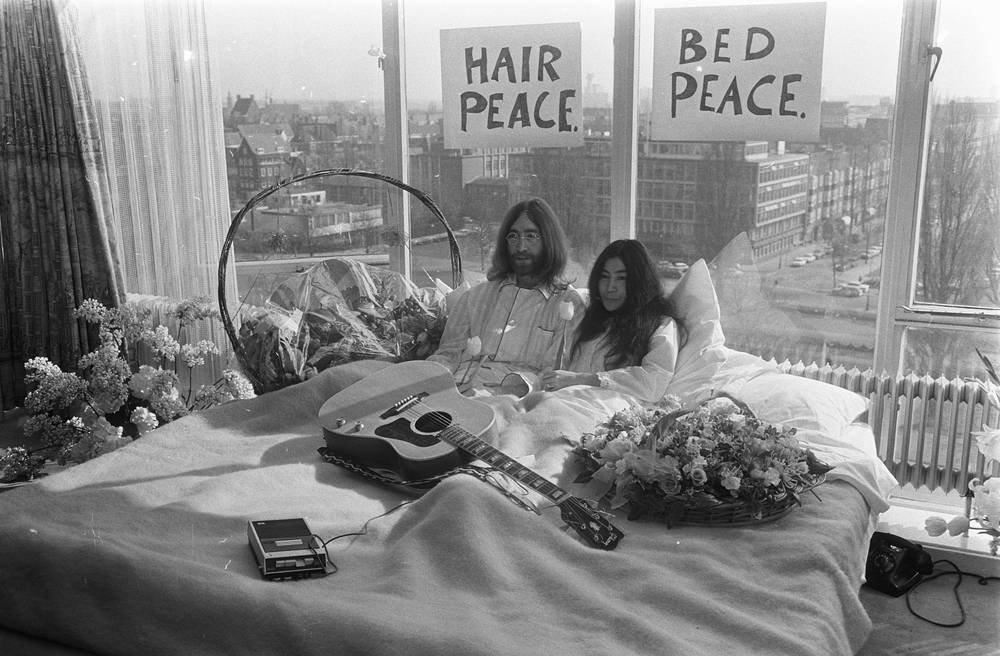A phenomenon that made its way into art in the context of the student revolts of 1968 is the so-called sit-in. This form of political activism was applied particularly by the civil rights movement in the battle against racial segregation in the USA. In buses or in restaurants, black activists demonstrated for equal rights using purely their physical presence. It was a form of occupation, similar to a guerilla action, which could be carried out simply by an individual person or a small group.
These sorts of sit-ins were initially not art, but rather an extremely effective strategy (especially in media terms). The images went around the world, became icons of civil disobedience and made a considerable contribution to the formation of public opinion. The student movement famously picked up on the strategy and organized so-called teach-ins and go-ins. The strategy ultimately reached art through Yoko Ono and John Lennon’s famous “Bed-in”. In March 1969, the freshly married couple spent a week living in a luxury hotel in Amsterdam.
There is an alternative to war. It's staying in bed and growing your hair.
The voyeuristic hopes of the press – after all, these were two newly married hippies (free love!) in a bed – were soon dashed: The action was a peace protest. “Stay in bed and grow your hair”, as an alternative to war and violence. Sitting in bed, the couple welcomed invited journalists and thus utilized the media attention their marriage generated to spread their message of peace.
While happenings, guerilla actions or sit-ins represented radical new ground for art, perhaps the most direct medium for political art was and is the poster. Around 1968, printed art enjoyed a veritable revival. Posters with original designs that somehow straddled Pop Art and Agit Prop were one way of utilizing creative potential directly “on the street”. These posters determined the aesthetic of so-called counter-culture. Taken together, they now form a kind of compendium of the most important political matters of the time. Dissemination and mass production signified, on the one hand, a kind of democratization, and on the other promised a mass impact. In many cases, we no longer know who created them. Nevertheless, big museums now collect these artworks.
Alternative art spaces sprouted up like mushrooms
Another medium that regained significance was magazines and newspapers that were produced and published by artists themselves. Here again democratization is an important key word, as is also the case in artist-led, alternative art spaces that sprouted up like mushrooms all over the world from 1968 onwards. These sorts of initiatives aimed to circumvent and decommercialize the museum and gallery system. Many lasted just a few years, but others remain to this day.

Many of the aforementioned strategies are still applied today in related forms. Happenings, for example, which were an attempt to bring art closer to life once again, are forerunners of Relational Art, the object of which is social interaction. The works by Rirkrit Tiravanija are one current example of this. His work “Untitled 2016” consists of T-shirts printed with the slogan “Freedom cannot be simulated”, and thus becomes an all-in-one social artwork, a printed mass product, and a political message.
Guerilla actions and flash mobs stimulate public discussions and experience massive media attention
Guerilla actions, on the other hand, are a specialty of the Guerilla Girls group, which is still in action today. The anonymous members of the group apply guerilla tactics to highlight grievances in the art world. Likewise flash mobs, such as the “1000 Gestalten” action against the G20 summit in Hamburg 2017, or the actions by the Zentrum für Politische Schönheit (engl. Center for Political Beauty) which are currently experiencing massive media resonance also make use of guerilla tactics. Like GAAG, they use the freedom of art as a space of possibility for protest and the media attention to stimulate public discussions.

The strategy of the sit-in is something we encounter time and again today. The Occupy movement, the demonstrations in Gezi Park or the Umbrella Revolution in Hong Kong were peaceful protests, the most important strategy of which was the occupation of public spaces. Although these are not strictly art projects, these movements nevertheless make use of media-effective visual strategies. An even more direct link can be drawn with Andrea Bowers’ “Radical Feminist Pirate Ship Tree Sitting Platform” (2013). What is now a work of art emerged directly from a protest action against deforestation in Arcadia, California. Jens Ullrich’s posters, for their part, refer directly to the poster culture that developed around 1968.

Despite all the similarities, some things have of course changed in the intervening 50 years. New social and political realities also offer new themes and sources of friction for political art. Added to which there are numerous media and technological possibilities that were not yet available at that time. Most significantly, the digital world has created new possibilities for presentation and places of exchange.
Is political art now back in the ivory tower?
Yet the cooperation with art institutions has changed considerably. Today, museums and exhibition houses no longer shy away from showing political and activist art. One might almost say that political art has in itself become a brand. So is political art now back in the ivory tower? Yes and no. Many artists now cultivate a different relationship with institutions than did the radical members back in the days of 1968. They accept the inevitable correlation between art and the market and have learned to cooperate with art institutions. Thus, rather than simply filling the streets or the kitchens of their shared dwellings with their works, they now consciously make use of art institutions as platforms for themselves. Instead of directing their critical potential against such establishments, they nurture it precisely by means of the opportunities the institutions offer.

